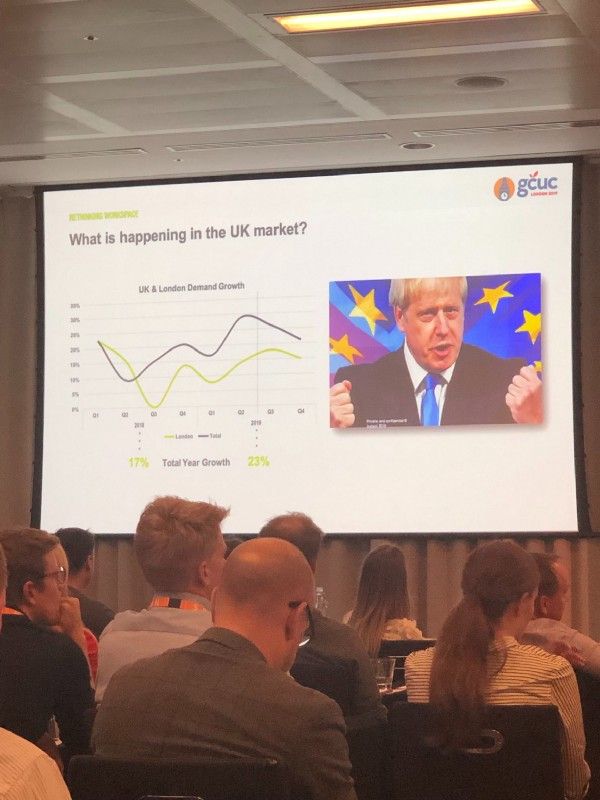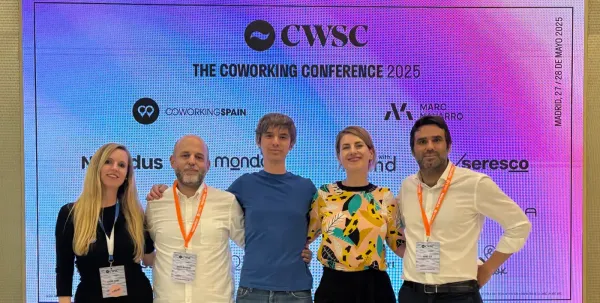GCUC UK 2019: Coworking, Flex Work, And Why They Matter
At GCUC UK 2019 in London, the past, present, and future of coworking all competed for our attention from September 23rd-24th. It may have been a brief few days, but both were jam-packed with content and a chance to see how coworking and flex work are reshaping one of the most prominent metropolises on the planet. So what’d we learn this year in London?
Coworking vs. Flexible Workspaces
The awkward teenage years of coworking are over. The industry has settled on a clearer set of definitions and by now most people will know what you mean when you talk about coworking or flexible workspaces:
Coworking is community driven, hospitality centered around humans.
Flexible workspaces (or Flex Work) are service-driven, large networks of spaces, business centres and serviced offices.
Despite this delineation, coworking and flexible workspaces continue to have large overlaps in service — with their difference expressed primarily in attitude, values, and in the people who work out of them.
Clearer definitions also hide the fact that many spaces are a mixture of both (in the UK 7% of spaces self define as a hybrid). So while a coworking space might set itself up as a totally different thing than a flex work space, they share enough DNA to easily blend several different types of “New Work.”
Profitability
Coworking space profitability hasn’t changed dramatically over the past few years, according to the DeskMag coworking survey. Of participating spaces, 43% are profitable; one third break even; and one in every four coworking spaces are in the red.

However, these numbers hide the real story behind many of these “unprofitables”: Many coworking spaces don’t aim to make a profit. Aside from non-profit organisations (12%), coworking spaces are often subsidised or covered by another business. Think corporations that offer an in-house open-plan coworking area as a perk to their employees, or a small company that uses public coworking to subsidize the cost of their space.
If you’re wondering which traits are most likely to be associated with profit, there are a few indicators. Roughly 90% of coworking spaces that generate a profit have been operating for longer than one year and have more than 200 members. Part of this is selection bias: If the space wasn’t making a profit, it probably wouldn’t have survived the first year. But it also speaks to the longevity of spaces that can survive that first difficult year.
Technology in Coworking Spaces
Space optimization has given way to human-centric design. Things like positive communication, health and wellness, mental health, and productivity. The new name of the game is finding ways to maximise interaction and human performance.
So what were the ideas thrown around at GCUC UK? Prioritize technology that meets the needs of the community. It may sound obvious, but the demographics and programming of each space define the technology needed, which in turn will attract more people who are seeking what you offer. So if you’re looking for a way to increase maximization, why not try talking to some of your members and seeing what they would want?
If you’re struggling to come up with ideas, here’s quick primer on tech that can make a difference.
Basics:
- Secure and fast wifi (an absolute must!).
- Fiber internet for sensitive information or developers — good security is on everyone’s mind.
- Access control cards, near-field communication (NFC), and bluetooth readers are essential (and it just so happens that Cobot’s got some great options for access control).
Trendy nice-to-have’s:
- Air quality. Ventilation, plants, and tech work together to shape your breathing experience (Note: I’m licensing this phrase so your air filtration startup had better act fast to get it).
- Light design. Have you heard of biophilic design? This one hits close to home for all of us working from an office in Berlin in the winter.
- Temperature. This seems obvious, but remember, not everyone’s optimal temperature is the same. Have you tried temperature zones or other ways to use the temperature to your members’ advantage?
Landlords and operators haven’t given up their interest in collecting troves of data on space occupancy, flow, and member productivity — but collecting and measuring that data is tricky. For example, it’s very hard to track the time a member spends in the space. Even with comprehensive wifi or door access integrations, multiple devices, cigarette breaks, privacy concerns, and security exit plans make it near-impossible to get truly accurate data.
A WeWork sales representative in attendance offered insight into their use of floor sensors to track occupancy, especially with larger teams and companies. They did not, however, answer when asked who owns that data.
Coworking Key Performance Indicators (KPIs)
- Member retention was the most mentioned KPI. Particularly when making lease deals or partnering with landlords.
- Net Promoter Score (NPS) for measuring customer satisfaction and loyalty.
- Jobs generated within the space by the companies that operate there (speaking of which, our friends and partners at Coworkies offer a service connecting applicants with jobs in and for coworking spaces).
- Prizes, investment, visibility and other indicators that the members and companies in the space are growing.
- Team (staff) growth. Important, but remember that it’s imperfect because your staff growth won’t scale 1:1 with membership or space growth.
- Visitors and other measurements of interest in your space.
Trends and Things to Watch
- Looking into different sources of interior design inspiration aside from offices (think theme parks and night clubs). Sounds like fun!
- Secondary markets in smaller cities or rural areas. This trend is already pronounced here in Germany and it’s been the talk of the town in other global conferences as well.
- Disaggregated working — people working from multiple locations throughout the day or week (from home, cafés, urban coworking spaces, rural coworking spaces, etc).
- AI automation. It’s coming to everything in our lives, but what role will it play in coworking?
- The growth of the international coworking industry. One speaker claimed that 91% of companies in Asia are considering using coworking spaces and flexible workspaces — but we could not verify that number with a source.
Off-Conference
We don’t want to end without talking about one of the best parts of our time in London. We attended an event on remote work with Brittnee Bond organized together with the London Coworking Assembly at Impact Hub Islington. As with most of our conference experiences, the best times are when you’re meeting, reconnecting, and generally enjoying the company of other coworking professionals. We’re looking forward to seeing you at next year’s GCUC UK (and probably a few times before then too!).

If you aren’t already using Cobot as your coworking management software, give it a go! You’ll find that our features can help you run your coworking space more effectively and grow your community. Just sign up for a free trial or a live demo session. And if you have questions, our support team is all ears!
Happy Coworking!



